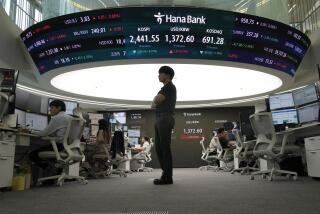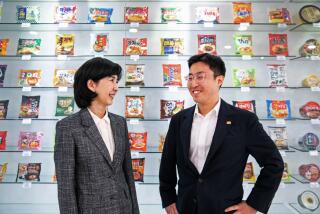Forging an Economic Miracle : South Korea Steel Firm Grows Into Giant in 20 Years
- Share via
KWANGYANG, South Korea — The housing that Pohang Iron & Steel has built for its workers here is set among trees and flowers and is surrounded by athletic fields, gymnasiums, a hospital and a performing arts center--all company-built.
The firm’s workers here and at its other plant in Pohang have never joined a union and never gone on strike, yet they are said to be the highest paid in the country.
When Pohang Iron & Steel--or POSCO, as it is called--was established 20 years ago, no one outside of South Korea thought that it would be successful. But the company has confounded the doubters and become one of the world’s most efficient steel producers.
The Kwangyang plant, which was opened only last year, turns out 933 tons of steel per worker a year, compared to an average of 528 tons in Japan and 262 tons in the United States. One type of steel that sells in South Korea for $320 a ton is shipped to Japan and sold for $450 a ton. Japanese mills charge $639 a ton for the same steel.
Elsewhere in recent years steel firms have struggled through hard times, but POSCO has operated from the beginning at capacity and has often exceeded that theoretical limit.
In short, POSCO has become a source of national pride, its founder and chairman a hero of South Korean industrialization and its labor relations a model for other companies here.
“We have a sense of contributing to the nation,” Yun Kyu Byung, 37, a team leader who has worked at Pohang for 11 years, told a recent visitor.
When production began in 1983 at Pohang, 250 miles southeast of Seoul, POSCO’s output was 1 million tons a year. Since then, the company has become the fifth-largest producer in the non-Communist world, with 12.2 million tons of annual capacity and $3.7 billion in annual sales.
May Rank No. 2 Soon
Next August the company will complete the 2.7-million-ton second phase of an ultra-efficient, integrated plant here at Kwangyang, 269 miles south of Seoul. In October, it will undertake another expansion project here aimed at increasing POSCO capacity to 17.6 million tons in 1990.
POSCO is then expected to rank second only to Japan Steel, which has announced plans to reduce capacity by 10 million tons to 24 million tons a year by 1990.
South Korea’s total steel production in 1990 is expected to total 21 million tons, a level that will place it among the world’s top 10 steel producers.
Park Tae Joon, POSCO’s chairman, said in a recent interview that if he has his way, the firm will stop expanding in 1990. Like other steel producers, he said, it must start diversifying. He added that as South Korea’s currency appreciates in relation to those of other nations, the competitive position of South Korean steel will deteriorate.
But Park, a former army general who has nurtured POSCO from its beginnings, admitted that he is not sure he will have his way regarding expansion. Many government officials and the public at large, he said, favor further expansion.
“Public opinion believes in manufacturing as much steel as possible,” he said. “Changing the people’s mind will require considerable indoctrination.”
Another POSCO executive, who asked not to be identified by name, predicted that the firm will continue to expand, that its capacity will be increased to more than 22 million tons and that other, smaller firms in South Korea will in the next decade turn out 8 million tons a year.
Jump in Demand Expected
Park said POSCO officials and officials at South Korea’s Ministry of Trade and Industry both expect domestic demand to reach 32.3 million tons by the year 2000, considerably in excess of planned domestic capacity. But Park said that if South Korea “were to try to approach 32.3 million tons in production, POSCO would have to build (a third) integrated steel mill (and) that’s inconceivable to me.”
South Korea’s increasing steel production capacity, led by POSCO, has become a source of concern abroad, concern that exports from this country will flood over-supplied world markets. But POSCO officials say the problems that Japan has encountered with excess production capacity serve as a warning to South Korea not to depend on exports to keep its steel mills operating.
“The world will no longer permit torrential floods of exports like Japan carried out in the past,” Park said. “It may be best to create capacity to manufacture about 26 million tons and operate that consistently . . . relying upon imports for shortages.”
Park acknowledged that POSCO is studying a fourth-phase expansion of the plant at Kwangyang. It would raise the company’s capacity to more than 20 million tons and encourage smaller South Korean firms to expand production, he said.
But he added, “I think we should act conservatively.”
South Korea’s overall steel exports, which last year amounted to 7.6 million tons, are expected to increase to only 8.7 million tons in 1990 because of rising demand at home. Domestic demand is expected to be 23.3 million tons in 1990.
Despite POSCO’s expansion, South Korea continues to be a significant importer of steel, almost all of it from Japan.
Park said he expects POSCO’s exports to the United States to increase as a result of a joint venture his firm has entered into with USX at Pittsburg, Calif. He said construction of a $350-million cold-steel finishing plant, to be completed in January, was started at Pittsburg after he and USX Chairman David M. Roderick received the enthusiastic support of Trade Representative Clayton K. Yeutter and the late Secretary of Commerce Malcolm Baldrige.
Roderick, he said, “later met U.S. government officials and secured a promise” to allow POSCO to ship steel coils to Pittsburg for finishing despite the foreign steel export restraint agreements the United States has negotiated with South Korea and other nations.
“I trust Mr. Roderick,” Park said.
USX officials have said that 1 million tons of steel coils would be shipped to Pittsburg for processing from POSCO’s Kwangyang plant if the import restraints are lifted as scheduled in October, 1989. They have said nothing about any government guarantees. While the import restraints were in effect, they have said, the Pittsburg plant will use steel from Gary, Ind., for the most part and only a limited amount of Korean steel.
Other POSCO officials said the firm will export 1.4 million tons of hot coil to Pittsburg beginning next year.
Park said POSCO’s expansion has made European and Japanese equipment suppliers so eager to sell to POSCO that it has been able to force them to share their technology with Korean firms. In what a company brochure calls “a fierce bidding war,” foreign firms reduced their prices for equipment for the Kwangyang plant by $266 million and offered attractive financing by obtaining loans from government export-import banks in Japan, Britain and Austria.
Best Wages, Treatment
Park takes special pride in POSCO’s harmonious labor relations, especially now that many other Korean workers are demanding increased pay and better conditions as the result of changes in the political climate.
Although there are no unions in POSCO plants, there has been since 1980 a “representatives committee” of 25 workers elected in companywide balloting.
“What is a union for?” asked Choi Sok Ho, 49, a former head of the committee. “It’s to get better wages and treatment, and we already have the best in Korea.”
Kang Pong Ki, 44, also a former chief representative, said that at POSCO “problems are resolved through dialogue.”
Still, labor strife elsewhere in South Korea has had an impact on POSCO. Wages were increased by 27% last year to keep the company in line with firms that did have labor problems, and another increase, of 18%, was approved in March. Choi and Kang acknowledged that such substantial increases would have been out of the question if other firms had not granted them.
Choi said the average wage at POSCO is 9 million won a year, about $12,200, including bonuses. Yun said that as a team leader he is paid 10.8 million won a year, including bonuses, or about $14,700. He said he works the standard POSCO schedule of six eight-hour shifts one week and seven eight-hour shifts the next.
POSCO workers are given only two Sundays off a month, for an average work week of 52 hours. But workers at other large South Korean companies don’t even do that well. For example, at plants operated by the big Daewoo Group, the average work week is 66 hours.
Sharing the Wealth
The percentage of total production costs that goes to labor at Pohang is only 5%. At Kwangyang, it is only 3.9%, while in Japan, according to a POSCO brochure, it is 23.3% of the total production costs.
POSCO’s 20,000 workers are being given a chance to become shareholders in the company. The government, which owned 100% of the shares at the beginning, sold 30.9% to private banks several years ago and is now giving up an additional 34.1%, which will leave it holding 35%. In a share-the-wealth program that President Roh Tae Woo promised in his election campaign last year, POSCO’s employees and low-income Koreans across the country are being given an opportunity to buy 32.4% of the company’s stock, at 10,500 won a share ($14.29), a 30% discount.
The public will have an opportunity to buy 1.7% of the company’s stock when it is listed next month on the Seoul Stock Exchange, at an initial price of 15,000 won ($20.41).
POSCO employees are required to hold the stock for five years, while low-income Koreans, defined as anyone with an income of less than $816 a month, will have to hold it for three years.
Team leader Yun said he expects the price of the stock to rise quickly, to at least 30,000 won ($40.82). He has 700 shares that he bought for $10,000, and this would give him an immediate potential profit of $18,570.
Park said executives at firms that are having labor trouble “should put themselves in the shoes of their employees and look at conditions a little more closely.”
“Workers want to live in good homes in a good environment,” he said, “and what Koreans want more than anything else is a good education for their children. The high schools our company has built send 10% of their graduates to Seoul National University (the nation’s most prestigious.) If you make that sort of effort, the workers will appreciate it.”
More to Read
Inside the business of entertainment
The Wide Shot brings you news, analysis and insights on everything from streaming wars to production — and what it all means for the future.
You may occasionally receive promotional content from the Los Angeles Times.










